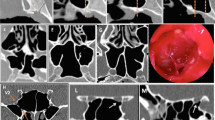Abstract
The purpose of our study was to assess the prevalence of variations and type of sphenoid sinus and its adjacent structures pneumatization and its significance. This prospective study included 114 patients who underwent CT of the paranasal sinuses. The CT scan in axial, coronal and mid sagital section were analysed to assess the type of pneumatization of the sphenoid sinus and its adjacent structures like; anterior clinoid process, greater wing of sphenoid and pterygoid process. The sphenoid sinus pneumatization was classified into Conchal, Presellar, and Sellar types, later comprised of sellar and post-sellar types. Out of 114 cases of pneumatized sphenoid sinus, 5.2% cases were conchal type, 26.3% cases Presellar type and 68.4% cases sellar type. The one or more adjacent structures was pneumatized in 71 (62.2%) of cases. The adjacent structures which found to be pneumatized are anterior clinoid process in 26.3%, Pterygoid process in 23.6%, and greater wing of sphenoid in 12.3% cases. The pneumatization of adjacent structures was more prevalent in sellar type of sphenoid sinus, followed by pre-sellar type and no pneumatization in conchal type. The anterior clinoid process pneumatization was present in 26.1% of cases, in which 3 (2.6%) cases in pre-sellar type and 27 (23.5%) cases in sellar type. It was unilaterally pneumatized in 13 (11.4%) and bilaterally in (17 (14.9%) cases. The pterygoid process pneumatization was present in 27 (23.6%) of cases, unilateral in 16 (14%) cases and bilateral in 11 (9.6%) cases. The Greater wing of sphenoid pneumatization was found in 14 (12.3%) cases, no cases in conchal types, 2 (1.8%) in pre-sellar type, and 12 (10.4%) in sellar type There was no statistically difference found in between right and left side of sphenoid sinus and its structure pneumatization. The extent of pneumatization of the sphenoid sinus has clinical and surgical implications in sinus diseases, sellar and central skull base lesions.















Similar content being viewed by others
References
Asal N, Bayar Muluk N et al (2019) Carotid canal and optic canal at sphenoid sinus. Neurosurg Rev 42:519–529
Bolger WE, Butzin CA, Parsons DS (1991) Paranasal sinus bony anatomic variations and mucosal abnormalities: CT analysis for endoscopic sinus surgery. Laryngoscope 101:56–64
Citardi MJ, Gallivan RP, Batra PS, Maurer CR Jr, Rohlfing T, Roh HJ, Lanza DC (2004) Quantitative computer-aided computed tomography analysis of sphenoid sinus anatomical relationships. Am J Rhinol 18(3):173–178
Dal Secchi MM, Lutaif Dolci RL, et al (2018) An analysis of anatomic variations of the sphenoid sinus and its relationship to the internal carotid artery. Int Arch Otorhinolaryngol 22(2)
El Kammash TH, Enaba MM et al (2014) Variability in sphenoid sinus pneumatization and its impact upon reduction of complications following sellar region surgeries. Egypt J Radiol Nucl Med 45(3):705–714
Hamid O, El Fiky L, Hassan O, Kotb A, El Fiky S (2008) Anatomic variations of the sphenoid sinus and their impact on trans-sphenoid pituitary surgery. Skull Base 18(1):9–15
Hammer G, Radberg C (1961) The sphenoidal sinus. An anatomical and roentgenologic study with reference to trans sphenoid hypophysectomy. Acta Radiol 56:401–422
Hewaidi G, Omami G (2008) Anatomic variation of sphenoid sinus and related structures in Libyan population: CT scan study. Libyan J Med 3(3):128–133
Hoseman W, Gross R, Göde U, Kühnel T, Röckelein G (1995) The anterior sphenoid wall: relative anatomy for sphenoidotomy. Am J Rhinol 9(3):137–144
Idowu OE, Balogun BO, Okoli CA (2009) Dimensions, septation, and pattern of pneumatization of the sphenoidal sinus. Folia Morphol (Warsz) 68(4):228–232
Kazkayasi M, Karadeniz Y, Arikan OK (2005) Anatomic variations of the sphenoid sinus on computed tomography. Rhinology 43(2):109–114
Kayalioglu G, Erturk M, Varol T (2005) Variations in sphenoid sinus anatomy with special emphasis on pneumatization and endoscopic anatomic distances. Neurosciences (Riyadh) 10(1):79–84
Kajoak SA, Ayad CE et al (2014) Computerized tomography morphometric analysis of the sphenoid sinus and related structures in sudanese population. Glob Adv Res J Med Med Sci 3(7):160–167
Lupascu M, Comsa GhI, Zainea V (2014) Anatomical variations of the sphenoid sinus. ARS Medica Tomitana 2(77):57–62
Lokwani MS, Patidar J, Parihar V (2018) Anatomical variations of sphenoid sinus on multi-detector computed tomography and its usefulness in trans-sphenoidal endoscopic skull base surgery. Int J Res Med Sci 6(9):3063–3071
Nathan DW, Lee AZ (2014) Complex anatomy of sphenoid sinus: a radiographic study and literature review. J Neurol Surg B Skull Base 75(6):378–382
Sirikci A, Bayazit YA, Bayram M et al (2000) Variations of sphenoid and related structures. Eur Radiol 10(5):844–848
Tomovic S, Esmaeili A, Chan NJ, Shukla PA, Choudhry OJ, Liu JK, Eloy JA (2013) High-resolution computed tomography analysis of variations of the sphenoid sinus. J Neurol Surg B Skull Base 74(2):82–90
Turkdogan FT, Turkdogan KA et al (2017) Assessment of sphenoid sinus related anatomic variations with computed tomography. Pan Afr Med J 27:109–116
Funding
This research received no specific grant from any funding agency, commercial or not for profit sector.
Author information
Authors and Affiliations
Corresponding author
Ethics declarations
Conflict of interest
There is no conflict of interest.
Human and Animal Rights
This research does not involve human or animals.
Additional information
Publisher's Note
Springer Nature remains neutral with regard to jurisdictional claims in published maps and institutional affiliations.
Rights and permissions
Springer Nature or its licensor (e.g. a society or other partner) holds exclusive rights to this article under a publishing agreement with the author(s) or other rightsholder(s); author self-archiving of the accepted manuscript version of this article is solely governed by the terms of such publishing agreement and applicable law.
About this article
Cite this article
Sagar, S., Jahan, S. & Kashyap, S.K. Prevalence of Anatomical Variations of Sphenoid Sinus and Its Adjacent Structures Pneumatization and Its Significance: A CT Scan Study. Indian J Otolaryngol Head Neck Surg 75, 2979–2989 (2023). https://doi.org/10.1007/s12070-023-03879-y
Received:
Accepted:
Published:
Issue Date:
DOI: https://doi.org/10.1007/s12070-023-03879-y




